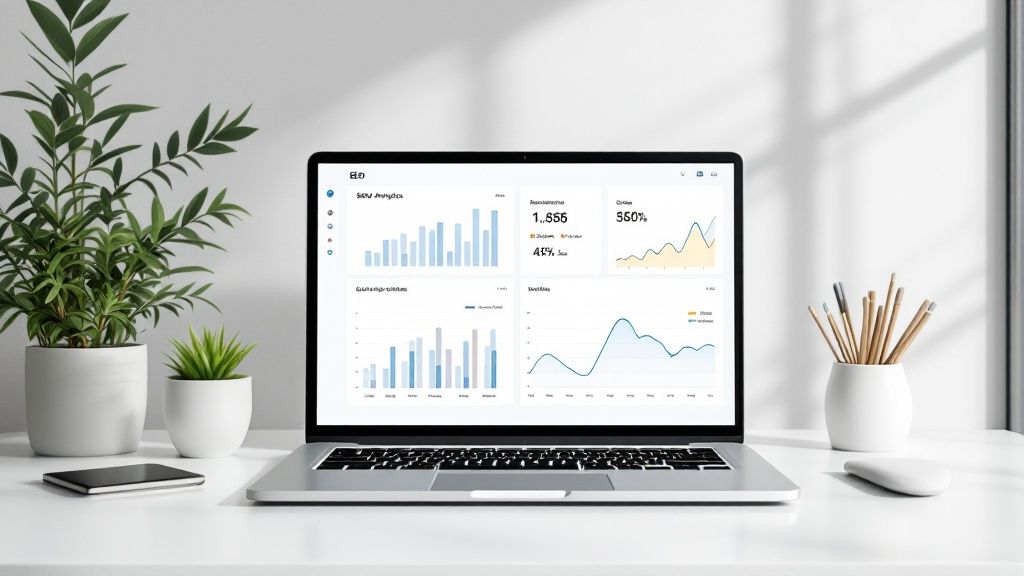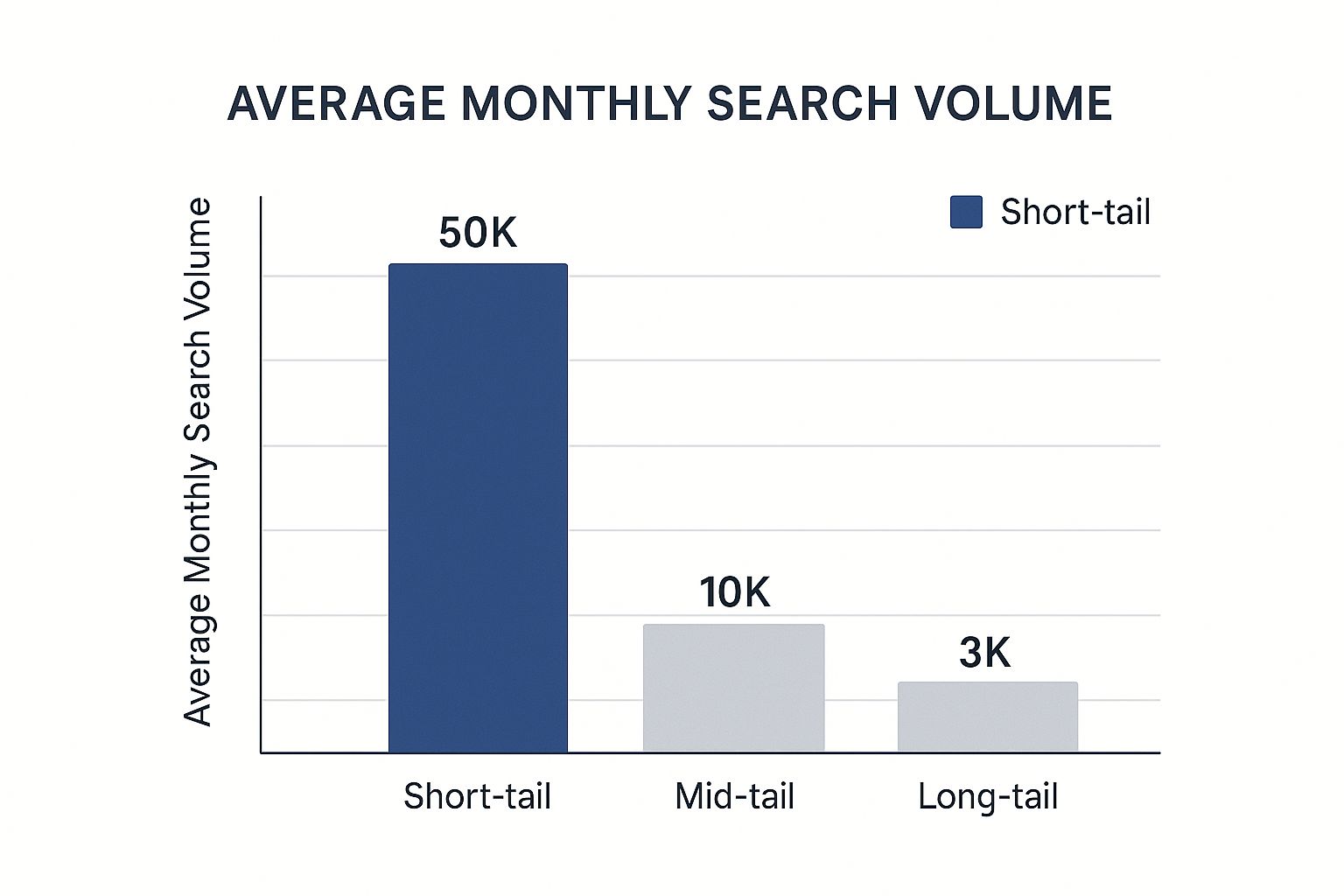Understanding What Makes Blog SEO Actually Work

Let's explore the core principles of successful blog SEO. This isn't about gaming the system, but about genuinely understanding what search engines value. Think of it as a conversation – you're learning their language and providing what they want: valuable content that users appreciate.
Beyond the Basics: It's About User Experience
Optimizing blog posts for SEO is much more than just inserting keywords. Imagine a library: books aren't just thrown onto shelves haphazardly. They're categorized and organized for easy access. Similarly, search engines favor blogs that provide a seamless and intuitive user experience.
This includes clear navigation and user-friendly design. Most importantly, it means content that effectively answers user queries.
Additionally, user behavior signals are crucial. Search engines monitor metrics like bounce rate (how quickly users leave your site) and time on page. If users leave quickly or don't interact, search engines infer your content may not be valuable. High engagement, conversely, indicates valuable content, boosting your rankings. You might be interested in: How to start a blog.
The Power of Organic Search
This emphasis on user experience is directly linked to the importance of organic search results. These are the non-paid results you see on platforms like Google. Organic search holds significant weight, accounting for approximately 94% of all search engine clicks (Find more detailed statistics here).
Furthermore, 75% of users don't venture past the first page of search results. This highlights the critical importance of ranking high. Creating high-quality, resonant content is paramount for blog SEO success.
Holistic SEO: More Than a Checklist
Effective SEO isn't a one-and-done task; it's an ongoing process. Think of it like tending a garden – consistent nurturing is key. This includes adding fresh, relevant content, cultivating strong backlinks, and addressing technical issues.
Therefore, a holistic SEO strategy is vital. This involves seamlessly integrating various SEO elements, from keyword research and content creation to technical optimization and performance tracking. A holistic approach creates a blog that ranks well and delivers real value to your readers, cultivating a loyal audience and driving long-term success.
Finding Keywords That Actually Drive Traffic
Forget generic keyword tools. To truly optimize blog posts for SEO, you need to uncover hidden keyword opportunities that your competitors haven't found yet. This means understanding not just search volume, but also search intent. What are users really looking for when they enter a specific phrase?
Beyond Search Volume: Understanding Search Intent
High search volume is enticing, but it can be misleading. Highly competitive keywords are tough to rank for, especially for new blogs. Instead of focusing only on volume, think about the commercial intent and ranking potential of a keyword. For example, "best running shoes" has high commercial intent (users are likely ready to buy). It also has moderate ranking difficulty. "How to tie running shoes," on the other hand, has lower commercial intent. However, it might attract a larger audience.
You might be interested in: Content strategy examples that actually work.
Unearthing Long-Tail Keywords
This is where long-tail keywords come in. These are longer, more specific phrases that target niche audiences. Think "best running shoes for marathon training on pavement" instead of just "running shoes." While individual long-tail keywords have lower search volume, together they capture a substantial amount of search traffic. They are also usually easier to rank for due to lower competition.

The infographic above shows the average monthly search volume for short-tail (50k), mid-tail (10k), and long-tail (3k) keywords. Short-tail keywords have higher individual volume. But the large number of long-tail variations leads to significant overall search volume. This makes long-tail keywords effective for driving targeted traffic.
Mapping Keywords to Content That Converts
Finding the right keywords is only half the work. The next step is creating content that connects with your audience and leads to conversions. This means developing high-quality, informative content that truly answers the user's search intent. If you are targeting "best running shoes for marathon training on pavement", your content should offer detailed reviews, comparisons, and recommendations.
The following table compares several popular keyword research tools. It highlights their best features, pricing, and ideal use cases to help you choose the best tool for your needs.
Keyword Research Tools Comparison
| Tool Name | Best Feature | Price Range | Ideal For |
|---|---|---|---|
| Semrush | Comprehensive SEO toolkit | $119.95 - $449.95/month | Businesses and SEO professionals |
| Ahrefs | Backlink analysis | $99 - $999/month | SEO experts and agencies |
| Moz Keyword Explorer | Keyword difficulty score | $99 - $599/month | Businesses and marketers |
| Ubersuggest | User-friendly interface | $29 - $99/month | Beginners and small businesses |
As you can see, each tool offers unique benefits and caters to different budgets and experience levels. Choosing the right tool depends on your specific requirements.
By understanding search intent and using long-tail keywords, you can build a keyword strategy that balances search potential with your expertise and your audience’s needs. This approach ensures that your blog posts rank well and attract the right users – those genuinely interested in your content. This targeted approach is crucial for how to optimize blog posts for seo effectively.
Writing Blog Content That Ranks and Resonates

Crafting blog posts that achieve high search engine rankings while captivating your readers requires a delicate balance. It's about understanding how search engines interpret content and how users engage with it. Mastering this balance is key to driving organic traffic and building a robust online presence.
Structuring Your Content for Readability
A well-structured blog post is like a well-organized library: information is easy to find and access. Use a clear header hierarchy, break content into digestible paragraphs, and incorporate formatting elements like bullet points and lists.
For example, using H2 and H3 headings guides readers through your content logically. Short paragraphs, around 2-4 sentences each, are easier to read than dense blocks of text. Combining this with bullet points for key takeaways enhances readability.
Incorporating Keywords Naturally
Keywords guide search engines to your content. However, keyword stuffing will deter readers and may negatively impact your SEO. Think of keywords as spices: they enhance the flavor, but too much can ruin the dish.
Integrate keywords seamlessly within your content, ensuring they fit naturally. Also, consider using long-tail keywords. These are longer, more specific phrases targeting niche audiences. Long-tail keywords often have less competition and can attract highly targeted traffic.
Creating Comprehensive Content
Search engines prioritize content that provides thorough and comprehensive answers. This positions your blog as a trusted source of information, building credibility with readers and search engines. Each blog post is an opportunity to become the go-to resource on a particular topic.
One effective strategy is addressing related subtopics and answering common questions related to your main keyword. This gives readers a well-rounded understanding of the subject. This deeper engagement also signals to search engines that your content is valuable, boosting rankings.
To achieve optimal SEO results, focus on providing valuable, engaging content. Long-form content, articles over 3,000 words, can attract 3x more traffic, 4x more shares, and 3.5x more backlinks than shorter articles of around 1.4k words (Find more detailed statistics here). For further guidance, check out our guide on How to Master Your Content Marketing Strategy Template. Read also: How to Master Your Content Marketing Strategy Template. Ultimately, creating resonant content that ranks well depends on delivering real value to your audience.
Technical Elements That Boost Your Rankings
Behind every successful blog post lies a strong foundation of technical SEO. These often-overlooked elements play a crucial role in how search engines understand and rank your content. Optimizing these technical aspects can significantly improve your search performance.
Page Speed and Mobile Responsiveness: The Need For Speed
Page speed is critical for both user experience and SEO. Slow-loading pages can lead to high bounce rates, signaling to search engines that your content isn't valuable. Imagine a physical storefront with long lines and slow service – customers are likely to leave. Similarly, online users won't stick around if your page takes too long to load. Aim for a load time of under two seconds, as Google has confirmed page speed as a ranking factor.
Mobile responsiveness is equally important. A growing number of users access content on their mobile devices. Ensure your blog adapts seamlessly to different screen sizes. A responsive design provides a consistent experience, no matter the device, contributing to positive user signals.
URL Structure and Internal Linking: Guiding Search Engines and Users
A well-structured URL helps search engines understand your content, much like a library uses a logical system to categorize books. Keep your URLs concise, descriptive, and relevant to the blog post's topic, using target keywords when appropriate. This clarifies your content's subject matter.
Internal linking is another key technical element. It connects related pages within your blog, providing further context and enhancing navigation. Internal links distribute link equity across your site, boosting individual pages' SEO value. They also guide readers to relevant content, improving user experience. Learn more in our article about The Differences Between B2B and B2C Marketing.
Image Optimization and Schema Markup: Enhancing Visibility
Images add visual appeal and boost engagement, but they also require technical optimization. Use descriptive alt text for each image, including relevant keywords where appropriate. This allows search engines to understand the image's content and improves accessibility for users with screen readers. Compressing images to reduce file size without sacrificing quality further improves page speed.
Schema markup, a type of structured data, gives search engines more context about your content. It's like adding labels to library shelves. It clarifies the content's format, topic, and other relevant information. This can lead to rich snippets in search results, boosting click-through rates.
Implementing Technical SEO Best Practices
Implementing these technical SEO elements doesn't have to be complicated. Blogging platforms like BlogMaker often have built-in features for optimizing page speed, mobile responsiveness, and other technical aspects. Utilize these tools and create a workflow to ensure every blog post follows technical SEO best practices.
Consistently applying these principles establishes a strong technical foundation, boosting your blog's visibility and search rankings. Combined with high-quality content, this optimization sets the stage for long-term SEO success.
Capturing Featured Snippets And Voice Search

Search engine optimization (SEO) is a dynamic field. Staying ahead means adapting to how people search for information. Two key components of modern SEO are featured snippets and voice search. These elements offer valuable opportunities to boost your blog's visibility and attract the right audience.
Understanding Featured Snippets
Featured snippets are concise summaries displayed at the top of Google’s search results. Often presented in a box format, they give users quick answers. This prime real estate is highly coveted. Imagine someone searching for "how to bake a cake." A featured snippet might appear with a summarized recipe directly from a blog post.
This immediate answer within the search results can significantly increase clicks to the featured blog. Featured snippets boast an impressive clickthrough rate (CTR) of 42.9%. This makes them a powerful tool for bloggers looking to increase engagement. Learn more about featured snippet statistics here.
Structuring Content for Snippets
Getting your content featured requires a strategic approach. This involves structuring your content around questions and answers, using clear headings, and delivering information concisely. Think of it as creating bite-sized, informative nuggets.
Use Question-Based Headings: Structure your H2 and H3 headings as questions. For example, if you're targeting "how to optimize blog posts for seo," use headings like "What are the Key Elements of On-Page Optimization?" This aligns your content with user search patterns.
Provide Concise Answers: Immediately follow each question heading with a clear, concise answer. This mirrors the snippet format and increases your chances of being featured.
Use Bulleted Lists and Tables: Organize complex information using lists or tables for a structured presentation. Search engines often favor this format, especially for comparisons or lists of tips.
Optimizing for Voice Search
Voice search is growing rapidly. People are increasingly using voice assistants like Siri and Alexa to search online. Optimizing for voice search is crucial for maximizing visibility. This involves understanding how people phrase voice queries, which tend to be more conversational.
Target Long-Tail Keywords: Focus on using long-tail keywords – longer, more specific phrases that reflect natural language. For instance, instead of targeting "SEO," consider "how to improve my blog's SEO for voice search."
Answer Questions Directly: Structure your content around answering common questions related to your topic. Since voice searches are often question-based, direct answers boost your visibility.
Focus on Local SEO (If Applicable): If you cater to a local audience, optimize your content with local keywords. Include your business address and contact information since many voice searches have local intent, like "find the best pizza near me."
By implementing these strategies, you can significantly improve your blog's visibility and drive more relevant traffic in today's ever-changing search environment.
Tracking Performance And Scaling Success
SEO is an ongoing journey. Optimizing your blog posts isn't a one-and-done deal. For continued success, you must track your performance and adapt your approach based on the data you gather. This means understanding which metrics matter most, and how to use them to refine your strategy.
Key Metrics for Blog SEO Success
Not every metric carries the same weight. Some offer much richer insights into the success of your SEO efforts. Here's a look at the essential metrics you should be tracking:
To help illustrate this further, here's a table summarizing these key performance indicators, what they measure, good benchmarks to aim for, and the tools you can use to track them.
Essential SEO Metrics To Track
| Metric | What It Measures | Good Benchmark | Tracking Tool |
|---|---|---|---|
| Organic Traffic | Visitors coming from search engines | Steady growth over time | Google Analytics |
| Keyword Rankings | Your position in search results for the keywords you're targeting | Top 3 positions | Google Search Console, Rank Tracking Tools |
| Click-Through Rate (CTR) | The percentage of users who click on your link in search results | Aim for above 2% | Google Search Console |
| Bounce Rate | Percentage of users who leave your site after viewing only one page | Aim for below 70% | Google Analytics |
| Time on Page | How long users spend on a single page | The longer, the better – aim to increase engagement | Google Analytics |
| Backlinks | Links from other websites to your content | Aim for high-quality links from relevant and authoritative sites | Ahrefs, Semrush |
These metrics provide a comprehensive overview of how your blog posts perform in search results and how users interact with your content. Leveraging tools like Google Analytics and Google Search Console empowers you to monitor these metrics and pinpoint areas for improvement.
Identifying and Improving Underperforming Content
By tracking your performance, you can identify content that isn't quite hitting the mark. Perhaps a blog post ranks poorly for its target keywords, or maybe users are leaving shortly after clicking through. These are clear signs that your content needs a refresh. Consider these questions:
- Does the content genuinely address the user's search intent?
- Is the content well-structured, easy to read, and engaging?
- Are there any technical SEO problems impacting the post?
Once you pinpoint the problem areas, you can revise the content, optimize the technical aspects, and promote it again to improve its performance. Features like custom URLs and scheduling within BlogMaker can further enhance your optimization efforts.
Scaling Success: Applying Winning Strategies
When you discover optimization techniques that work, don't limit them to a single post. Apply these successful strategies across your entire blog. Create a consistent workflow for optimizing both new and existing content based on your proven experiments. This creates a ripple effect, consistently improving your overall SEO performance.
Staying Ahead of the Curve: Adapting to Algorithm Changes
Search engine algorithms are always changing. What's effective today might not be tomorrow. Stay informed about the latest SEO best practices by following industry blogs and be ready to adjust your strategies. This proactive approach helps you maintain and even improve your rankings, even when the search landscape shifts. Consider using competitor analysis and content refreshing strategies to stay ahead of the curve and give new life to older posts. This will further optimize your content for “how to optimize blog posts for seo.”
Key Takeaways
Optimizing blog posts for SEO is a complex process. However, concentrating on core elements can significantly boost your search rankings and organic traffic. This section summarizes the most important takeaways into actionable steps you can implement right away. These aren't quick solutions, but sustainable SEO practices that build over time, establishing a foundation for long-term success.
Content Is King, but Context Is Queen
High-quality, engaging content is still paramount. However, understanding search intent is equally crucial. Ask yourself: what information are users really looking for when they enter a specific query? Your content should thoroughly address this question, offering value beyond basic keyword matching. For example, someone searching for "how to optimize blog posts for seo" isn't simply looking for a list of keywords. They're seeking practical strategies, actionable advice, and real-world examples.
Technical SEO: The Unsung Hero
Technical aspects are often overlooked, but they're fundamental to how search engines interpret and rank your content. Prioritize page speed, guarantee mobile responsiveness, and create clear, descriptive URLs. Think of these elements as the underlying structure of your content – without a solid foundation, everything else can fall apart.
Featured Snippets and Voice Search: The New Frontier
The way people search is changing. Featured snippets and voice search present new opportunities for visibility. Format your content with question-based headings and provide concise answers to secure featured snippets. Learn more in our article about How To Make Money Blogging Online As A Solo Blogger. For voice search, concentrate on long-tail keywords and natural, conversational language, reflecting how people speak in everyday conversations.
Measurement and Refinement: The Cycle of Success
SEO isn't a one-time project; it's a continuous process. Monitor essential metrics like organic traffic, keyword rankings, and bounce rate. This data reveals what strategies are effective and where you need to make adjustments. Regularly review underperforming content, pinpoint areas for improvement, and adapt your strategy based on data-driven insights.
Key Elements for On-Page Optimization
- Keyword Research: Find relevant keywords with achievable ranking potential.
- Engaging Content: Create comprehensive, reader-focused content that fulfills search intent.
- Technical Optimization: Focus on page speed, mobile responsiveness, and well-structured URLs.
- Content Structure: Utilize headings, subheadings, bullet points, and visuals to improve readability.
- Internal and External Linking: Link related content within your site and reference reputable external sources.
- Meta Descriptions: Write compelling descriptions that encourage clicks from search engine results pages.
By focusing on these key takeaways and applying the recommended strategies, you can substantially enhance your blog's SEO performance. Remember, consistent effort and continuous optimization are essential for achieving lasting results in the ever-changing realm of search engine optimization. Ready to improve your blog creation process and boost your SEO efforts? Explore BlogMaker, the all-in-one platform designed to empower content creators. Offering features like custom URLs, scheduling, SEO optimization tools, and a user-friendly interface, BlogMaker lets you concentrate on your strength: crafting excellent content that ranks well.
SEO–ready, Analytics, No–code.
Your Content Publishing Engine
Deliver your SEO–driven content!
Visit BlogMaker.app



